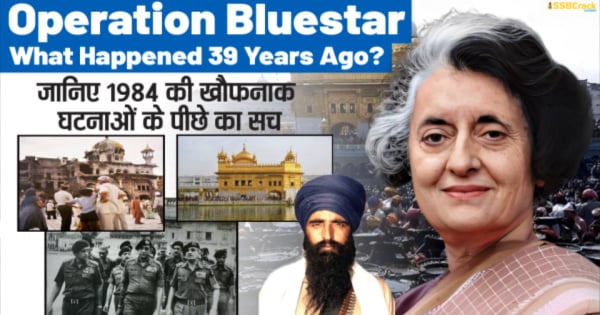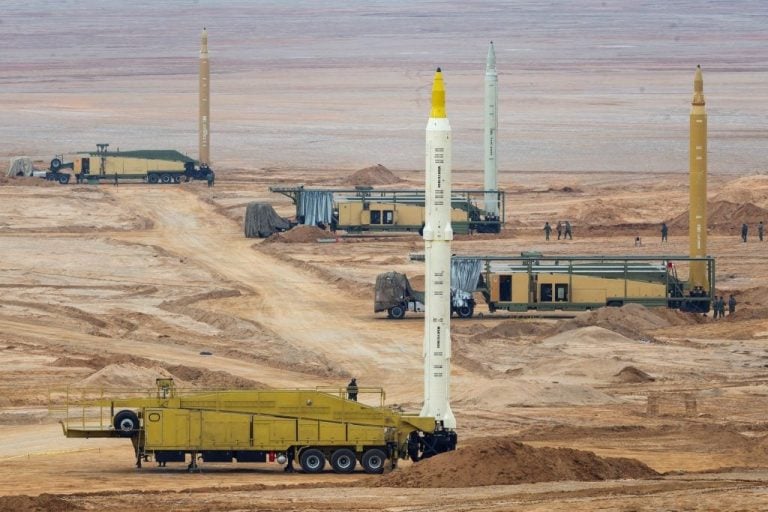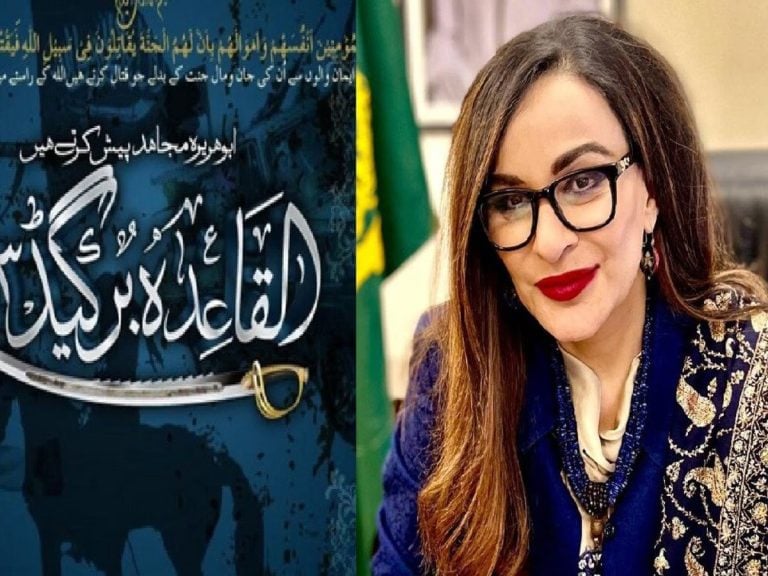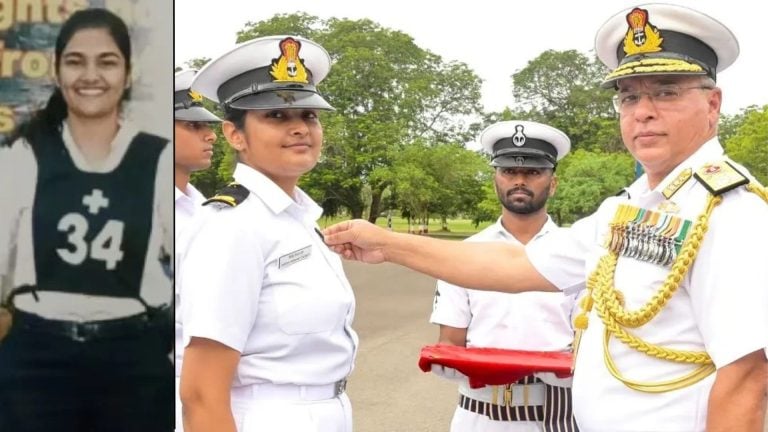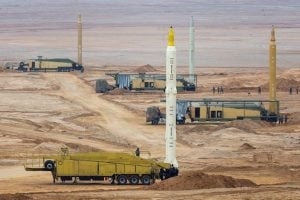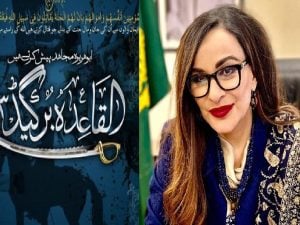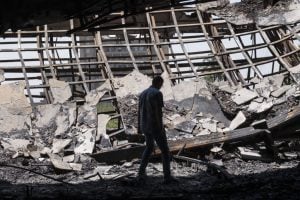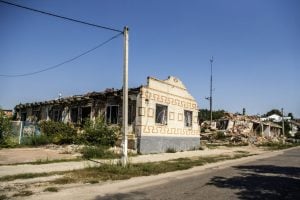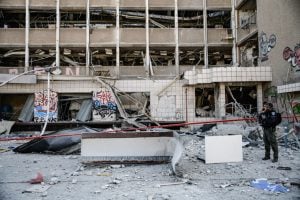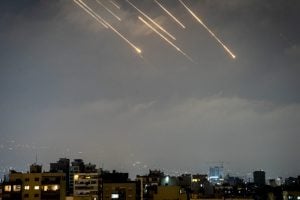The Indian Army stormed the Golden Temple in Amritsar in June 2023 to flush out militant leader Jarnail Singh Bhindranwale and his followers during Operation Bluestar. An Indian Army operation conducted in June 1984 in Amritsar, Punjab, to flush out militants led by Jarnail Singh Bhindranwale, a former leader of the Sikh seminary Damdami Taksal and a key figure in the growing separatist Khalistan movement at the time.
Why In The News?
- June 2023 Marks 39 Years Of Operation Bluestar, In Which The Indian Army Stormed The Golden Temple In Amritsar To Flush Out Militant Leader Jarnail Singh Bhindranwale And His Followers.
What Was Operation Bluestar?
- An Indian Army Operation Carried Out In June 1984 In The Golden Temple In Amritsar, Punjab, To Flush Out Militants Who Were Led By Jarnail Singh Bhindranwale, A One-time Leader Of The Sikh Seminary Damdami Taksal And A Key Figure In The Growing Separatist Khalistan Movement At The Time.
The Birth Of the Idea Called “Khalistan”:
- It Was Born In The Aftermath Of The Partition Of India In 1947. Punjab, The Home Of The Majority Sikh Community, Was Also Divided Into Two. This Led To A Sense Of Loss Among Indian Sikhs, With Culturally And Religiously Important Cities, Such As Lahore And Nankana Sahib, Going To Pakistan.
- Additionally, There Was Some Discontent Over A Few Administrative Issues, Like River Water Sharing With Other States, Which Led To Demands For Autonomy -And Then For A Sovereign Sikh State From Some Quarters. It Is Also Believed That Pakistan Aided The Movement With Arms And Funds.
- For Autonomy, In 1966, The Erstwhile Punjab State Was Divided Into The Hindi-speaking, Hindu-majority States Of Himachal Pradesh And Haryana, And The Punjabi-Speaking, Sikh-Majority Punjab. However, By The 1970s, The Separatist Khalistan Movement Was In Full Swing – In India And Abroad.
The Build-up For Khalistan Movement:
- In This Scenario Emerged Jarnail Singh Bhindranwale, A Firebrand Preacher Who Positioned Himself As “The Authentic Voice Of The Sikhs” In A Period Of Political Uncertainty.
- While Bhindranwale Was Initially Courted By The Congress To Counter The Shiromani Akali Dal’s Influence In The State, By The Early 1980s He Had Become “A Problem” – He Found A Captive Audience Among The Youth, The Activities Of His Followers Were Becoming Increasingly Violent, And Bhindranwale Himself Was Engaging In Aggressive Rhetoric.
- In 1982, He Became A Part Of A Civil Disobedience Movement Launched By The Akalis, Called The Dharam Yudh Morcha, And Moved To The Akal Takht Inside The Golden Temple Complex To Evade Arrest From The Authorities.
- In 1983, A S Atwal, Deputy Inspector-general Of Police (DIG), Was Shot Dead After Praying At The Golden Temple And His Body Was Left To Decay. By 1984, The Govt Finally Decided To Step In By Sending In the Armed Forces To Flush Out Bhindranwale And His Followers From Their Hideout Inside The Golden Temple.
The Dreadful “Operation Bluestar”:
- At This Point, The Golden Temple Complex Was Nothing Short Of A Fortress. Over A Period Of Months, Bhindranwale’s Men Had Smuggled In A Huge Cache Of Arms And Ammunition Inside The Complex And Placed Guns Strategically For Defence.
- Furthermore, Under The Leadership Of Major General Shahbeg Singh, Who Had Been Dismissed By The Indian Army Over Corruption Charges, Bhindranwale’s Men Received Extensive Military Training.
- On June 1, Four Days Before The Army Actually Entered The Golden Temple Complex, The First Shots Were Fired At The Temple By The CRPF To, According To Reports, “Assess The Training And Strength Of The Militants Inside”.
- On June 3, A 36-hour curfew Was Imposed On The State Of Punjab With All Methods Of Communication And Public Travel Suspended, Electricity Lines Cut And Complete Media Censorship.
- The Army Finally Commenced The Operation On The Night Of June 5. The Initial Thrust Of The Operation Was To Neutralize The High-perched Defensive Positions Built By Bhindranwale’s Men In The Golden Temple Complex. As Per The Army, Any Assault On The Temple Compound Could Not Be Successful If They Remained In Play.
- As The Outer Defences Of The Temple Complex Fell, The Army Was Still Hopeful For A Quick Capitulation. What They Did Not Take Into Account Was That The Militants Were Not Necessarily Making “Rational” Decisions. The Troops’ Entry Into The Golden Temple Was Met With Furious Fire From Inside.
- The Troops’ Attempts To Capture The Parikrama Or The Circumambulatory Path Around The Golden Temple. The Unanticipated Resistance Faced By The Troops Resulted In The Commanders Calling For Tank Support. Tanks Began Entering The Temple Complex At Around 10 Pm On June 5.
- Over The Next 12 Hours, The Army’s Vijayanta Tanks Shelled The Golden Temple’s Akal Takht – One Of The Five Seats Of Power As Per Sikh Belief. This Was Bhindranwale’s Location, Where Resistance Was The Strongest.
- Tanks Had Been Initially Avoided Over Possible Structural Damage To The Complex – Something That Would Anger The Sikh Community Further. However, Once Tanks Were Brought In, They Proved To Be Extremely Effective.
- As Dawn Broke On June 6, The Main Defences, Comprising Machine Guns And Chinese-made RPGS, Had Largely Been Neutralized. At Around 11 Am, Some 25 Militants Rushed Out Of The Building, Firing At Random And Running Straight Towards Troops, Who Gunned Down Most Of Them.
- The Generals Guessed That The Mad Dash Was An Indication That Bhindranwale Was Either Dead Or Wounded Or Had, Confirming Their Worst Fears, Escaped.
- Fortunately For The Armed Forces, The Firebrand Preacher Had Not Escaped. As The Troops Finally Entered The Akal Takht, Now In Ruins, They Found Bhindranwale Dead, Reportedly In A Heap Of “About 40 Corpses”. The Last Remaining Militants Either Surrendered Or Were Killed By June 10.
The Aftermath:
- While The Army Initially Placed Total Casualties At 554 Militants And Civilians Dead, 83 Troops Dead (4 Officers, 79 Soldiers) And 236 Wounded Among Government Forces, Other Estimates Peg The Number Of Casualties As Much Higher.
- Though The Army Has Always Claimed It Did Everything To Protect Civilians, Including Making Announcements On Loudspeakers Prior To The Attack, Its Actions Have Been Questioned. In 2017, A Sessions Court In Amritsar Ruled That There Was No Evidence Of Such Warnings.
- There Were Reverberations Across The Country. The Resentment Among Some Members Of The Sikh Community Over The Operation Saw Its Gravest Manifestation On October 31, 1984, When PM Indira Gandhi Was Assassinated By Her Two Sikh Bodyguards, Who Blamed Her For The Attack.
- Her Assassination Would Trigger Some Of The Worst Communal Violence Ever Witnessed In India, As Sikhs Were Openly Targeted And Killed. Many In The Govt And The Congress Party, Were Accused Of Playing An Active Role In The Anti-Sikh Riots.
- Crucially, While Bhindranwale Had Been Killed, His Death Made Him An Almost Mythological Figure In Some Ways. The Events At Golden Temple Did Not End Violence In Punjab, With Rising Militancy Accompanying Rising Repression From The State And The Armed Forces Well Into The 1990s.
- KPS Gill, Former DGP Of Punjab, Wrote In The Punjab Story: “In Hindsight, Operation Bluestar Was Possibly The Single Most Significant Act Of Political Overreaction And Military Incompetence That Gave A Lease Of Life To A Movement That Could Easily Have Been Ended In The Mid-1980s.”
Also read:
- 20th ASEAN-India Summit & 18th East Asia Summit Highlights
- Manipur Police Register Criminal Case Against Assam Rifles
- Pakistan’s Ex-PM Imran Khan Jailed For 3 Years In ‘Toshakhana Case’
- Four Years After Removal Of Art 370: How Is The Actual Situation In Kashmir?
- Putin’s Critic Alexei Navalny Sentenced To 19 More Years In Prison
- Delhi Services Bill Tabled In Lok Sabha: Govt Of NCT Of Delhi (Amendment) Act, 2023
- Gurugram Nuh Violence: How A Religious Procession Turned Into A Communal Clash
- Govt Imposes Import Restrictions On Laptops, Tablets, Computers
- How Climate Change Is Altering The Colour Of The Oceans?
- New IPCC Assessment Cycle Begins: Why Is It So Significant?
- Difference Between NATO Vs Russia? [Explained]
- Italy Regrets Joining China Belt & Road Initiative (BRI)
- What Is Doping: Why Is It Banned In Sports?
- India Tiger Census 2023: India Is Now Home To 75% Of Tigers In The World
- Military Coup In Niger – President Detained, All Institutions Suspended
- No-Confidence Motion Against PM Modi’s Government
- Elon Musk’s SpaceX Rocket Punches Hole In Ionosphere
- Israeli Parliament Passes Controversial Law Stripping Supreme Court Of Power
- Significance Of 1999 Kargil War: How It Became A Major Game Changer For Indian Military?
- Controversy Over Movie Oppenheimer Gita Scene: How Are Films Certified In India?
- The Curious Case Of Qin Gang: China’s Foreign Minister Who Went Missing
- Twitter’s Iconic Blue Bird Logo Set To Be Replaced By An X Logo
- India Pulls Out Of Games In China Over Stapled Visas For Arunachal Athletes
- PM Modi Urges Sri Lanka President To Implement 13th Amendment
- India Pulls Out Of Games In China Over Stapled Visas For Arunachal Athletes
- Rajasthan CM Sacks Minister After Remarks Over Crimes Against Rajasthan Women
- Manipur Sexual Assault: Video Sparks Outrage Across The Country
- BRICS Summit 2023 In August: Why Putin Won’t Go To South Africa For The Summit?
- Robert Oppenheimer: The Father Of Atomic Bomb, Impact Of Bhagavad Gita On Him
- Russia-Ukraine Black Sea Grain Deal, Why Russia Has Halted It?
- Henley Passport Index 2023, India Passport Ranked 80th
- Indian Opposition Parties Form ‘INDIA’ Alliance, 26 Parties Unite For 2024
- Britain Joins Asia-Pacific Trade Group ‘CPTPP’ – Biggest Trade Deal Since UK Left EU
- NITI Aayog Report On National Multidimensional Poverty Index
- PM Modi UAE Visit: Highlights & Key Takeaways
- PM Modi’s Visit To France: Highlights & Key Takeaways
- NATO Summit Vilnius 2023: Highlights & Key Takeaways
- Turkey Supports Sweden’s Bid For NATO Membership At Vilnius Summit 2023
- Why ISRO Wants To Explore The Moon’s South Pole: Chandrayaan-3 Mission
- Bengal’s Panchayat Polls Turned Violent: SSB Interview Topic 2023
- First Ever IIT Campus Outside India In Tanzania
- RBI’s Report On “Internationalisation Of Rupee” Why And What Are The Benefits?
- Japan To Release Nuclear Wastewater Into Ocean – Gets Approval From IAEA
- PM Modi Chairs 23rd SCO Summit: Highlights & Key Takeaways
- Israel Raids Jenin Camp: Massive Military Operation In West Bank
- Dutch King Apologizes For Netherlands’ Role In Slavery: A Look At The Dutch Role In History
- Constitutional Crisis In Tamil Nadu: The Tussle Between Governor & DMK Government
- Why Has France Been Engulfed By Protests Again?
- Paris Summit – World Leaders Unite For A New Global Financing Pact
- India Ranked 67th On Energy Transition Index – Sweden On Top Of List By World Economic Forum
- Four Minor Planets Named After Indian Scientists
- NASA Recovers 98% Water From Urine & Sweat On ISS: Breakthrough In Long Space Missions
- ESA Space Telescope Euclid Is All Set For Launch To Observe Dark Side Of Universe
- PM Modi’s Trip To USA: Key Takeaways & Highlights
- PM Modi-Led Yoga Session Creates A New Guinness World Record
- Sajid Mir, The Mastermind Behind 26/11 – His Designation As Global Terrorist Blocked By China
- UN Adopts First Historic ‘High Seas Treaty’ To Protect Marine Life
- International Yoga Day 2023 – How It Was Celebrated Across The World?
- Gender Apartheid – Why Is Afghanistan At Stand Off With UN?
- Gandhi Peace Prize 2021 For Gita Press Why It Triggered A Congress-BJP Brawl?
- The New Pride Flag – Why The Change & What The Colours Signify?
- 48 Years Of Emergency – PM Modi Refers It As India’s Darkest Period In Mann Ki Baat
- Groundwater Extraction Has Tilted Earth’s Spin – How Will It Impact The Climate Change?
- Europe’s Worst Migrant Boat Disaster – 78 Dead, Hundreds Missing Off Greek Coast
- MOVEit Global Hacking Attack – Government Agencies In The USA Targeted
- Karnataka Govt Decides To Repeal Anti-Conversion Law: Why Was The Law Controversial?
- IIT Bombay Among Top 150 Varsities In QS Rankings 2024
- China’s Xi Jinping Backs ‘Just Cause’ Of Palestinian Statehood – Chinese Middle Eastern Diplomacy
- Turkey Won’t Back Sweden’s Bid To Join NATO – Why Is Erdogan Against Sweden’s Application
- UN Report Reveals Chronic Bias Against Women – 25% Of Population Thinks Beating Wife Justifiable
- Zinnai – Space Flower Grown On International Space Station By NASA – Why Is It Significant?
- Who Are Meira Paibis: Manipur’s ‘Torch-Bearing’ Women Activists?
- USA Set To Re-Join UN Cultural Agency UNESCO
- CoWIN Data Leak – Aadhaar, PAN Card Info, On Covid Portal, Made Public By Telegram
- $10bn Investment Deals Signed At Arab-China Summit – Is Arab World Moving Towards China?
- Cyclone Biparjoy Turns Into Extremely Severe Cyclonic Storm – 10 Points To Know
- PM Modi’s Trip To Egypt: Highlights & Key Takeaways
- El Nino Returns After 7 Years: Will Impact Second Half Of Monsoon
- Europe’s Copernicus Programme Completes 25 Years: SSB Interview Topic
- Trump Charged Over Secret Documents In A First For An Ex-US President
- 39 Years Since Operation Bluestar: What Actually Happened?
- Wagner Chief Vows To Topple Russian Military Leaders
- Arctic Could Be Ice-Free In The Summer By 2030: SSB Interview Topic
- PM Modi’s School In Gujarat Will Host Students From Across India
- Major Dam Collapse In Ukraine – Accuses Russia Of Blowing Up Kakhovka Dam
- Microsoft To Pay $20 Million For Illegally Collecting Children’s Info
- NIRF Ranking 2023: IIT Madras Tops The List For 5th Consecutive Year
- TRAI’s ‘Digital Consent Acquisition’ (DCA) Facility’- Unified Platform For Customers’ Consent
- 34th Anniversary Of Tiananmen Square Protest – Hong Kong Police Detains Activists
- Asia Security Summit 2023 Shangri-La Dialogue Begins Amid China-US Tensions
- Coromandel Express Accident – How 3 Trains Derailed, Crashed At Same Place In Odisha
- Law Commission Against Scrapping Of Sedition Law, Says It Will Protect India’s Unity
- Radical Changes In NCERT Textbooks – Poverty, Inequality, Democracy Among Topics Removed
- India GDP Data Beats Expectations – Stays Fastest Growing Economy
- Maharashtra’s Ahmednagar To Be Renamed Ahilyanagar
- Scientists Discover 2nd Moon Near Earth Orbiting Since 100 BC
- Erdogan’s Victory In Turkish Election – What Can Be The Impact On India?
- NASA Alert! GIANT Asteroid Racing Towards Earth
- Uganda Signs Anti-Gay Law With Death Penalty – Sparks Global Outrage
- RBI’s ‘Lightweight’ Payments System For Emergencies – An Alternative To UPI, NEFT, RTGS
- Significance Of ISRO’s Newly Launched NavIC Satellite In Regional Navigation
- What Is The Model Prisons Act – Reforms In The Indian Prisons System?
- Global Plastic Treaty – Negotiations Underway For A Plastic-Free Planet: SSB Interview Topic
- China Sends First Civilian Astronaut To Space As Shenzhou-16 Blasts Off
- US Congressional Panel Suggests Making India Part Of NATO Plus: SSB Interview Topic
- India Conducts National Cyber Defence Exercise
- What Is XPoSat, India’s First Polarimetry Mission?
- Germany Falls Into Recession As Inflation Hits Economy
- Bangladesh Faces Fuel Crisis – Dollar Shortage Issue
- Australian Universities Ban Student Applications From Certain Indian States
- What Is Volt Typhoon: China-Backed Hackers Targeting USA?
- Death Of Six Cheetahs At Kuno National Park: SSB Interview Topic 2023
- India-Australia Relations Get Stronger – What Is Migration Deal?
- What Is Sengol: To Be Placed In The New Parliament Building?
- Annual Misery Index – India Ranks 103 Out Of 157 Nations: SSB Interview Topic
- Russia Pressures India For Help To Avoid Getting Blacklisted By FATF
- What Is Mission LiFE – How It Will Fight Against Climate Change?
- What Is The ‘Pandemic Treaty’: How WHO Could Fight Future Pandemics?
- Assam CM Himanta Biswa Sarma Announces Withdrawal Of AFSPA
- El Nino Could Hit World Economy By $3 Trillion? SSB Interview Topic 2023
- Tussle Between Delhi Govt And Centre – Delhi Ordinance Issue: SSB Interview Topic
- China Braces For New Covid Wave With Up To 65 Million Weekly Cases
- Colour-Coded Warnings By The IMD: SSB Interview Topic 2023
- Saudi Scripts History As First Arab Woman Astronaut Lifts Off Into Space
- Controversy Behind Inauguration Of Parliament Building: SSB Interview GD Topic
- Uniform Civil Code: Is Time Ripe For the Indian Government To Act On It?
- Indian-Origin Ajay Banga To Be The Next World Bank President
- AI ‘Godfather’ Geoffrey Hinton Quits Google Warns Of Danger Ahead
- India Ranks 161 Out Of 180 Countries – World Press Freedom Index
- Supreme Court Rules It Can Directly Grant Divorce To Couples: SSB Interview GD Topic
- Kashmir All Set To Hold G20 Summit In India
- Go First Airlines Files For Insolvency: SSB GD Topic
- India Becomes Europe’s Largest Supplier Of Refined Fuels
- What Is The Met Gala – Fashion’s Biggest Night?
- Clashes In France Against Pension Reforms By Macron Govt
- Why Are Indian Wrestlers Protesting Against WFI Chief?
- China Offers Ukraine To Mediate To End War With Russia
- 50 Years Of Kesavananda Bharati Case: SSB Interview Lecturette Topic
- Assam-Arunachal Pradesh Border Dispute: SSB Interview Lecturette Topic 2023
- Same-Sex Marriages In India: Key Supreme Court Verdicts On LGBTQ Rights
- What Is China Plus One? SSB Interview Lecturette Topic 2023
- India-Maldives Relations: SSB Interview Lecturette Topic 2023
- India-Bangladesh Relations: SSB Interview Lecturette Topic 2023
- India-Japan Relation: SSB Interview Lecturette Topic 2023
- Geopolitical Importance Of The Indian Ocean: SSB Interview Lecturette Topic 2023
- All About Paris Club: SSB Interview Lecturette Topic
- PM Narendra Modi Has Been Named The Most Popular Leader In The World
- Hindenburg Report On Adani – Here’s What You Need To Know
- India At WEF Davos Summit 2023: Here Are 10 Key Highlights
- Pakistan Economic Crisis 2023: SSB Interview Topic [Fully Explained]
- Joshimath Crisis: What Does “Land Subsidence” Mean, And Why Does It Happen?
- Top 10 Animal Conservation Projects In India [MUST WATCH]
- What Is Shanghai Cooperation Organisation (SCO) Summit 2022? [Fully Explained]
- 20 SSB Interview Questions On Russia Ukraine Crisis
- What Is The (India-Israel-UAE-USA) I2U2 Summit? [Fully Explained]
- What Is International North-South Transport Corridor (INSTC)?
- What Is Sri Lankan Crisis? [Fully Explained]
- What Is The BIMSTEC Grouping And How Is It Significant? [EXPLAINED]
- What Is The Places Of Worship (Special Provisions) Act, 1991? [Explained]
- What Is Bodo Accord | SSB Interview Notes [Fully Explained]
- What Is AFSPA: Armed Forces (Special Powers) Act?
- What Is G20 Or Group Of Twenty Countries?
- What Is AFSPA: Armed Forces (Special Powers) Act?
- What Is The Financial Action Task Force (FATF)? [Fully Explained]
- What Is Quadrilateral Security Dialogue (QUAD)?
- Difference Between NATO Vs Russia [Expained]
- What Is United Nations Security Council (UNSC) [Explained]
- Everything You Need To Know About SAARC: South Asian Association For Regional Cooperation
- All About Russia Ukraine War: SSB Interview Topic [Fully Explained]


